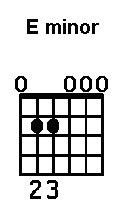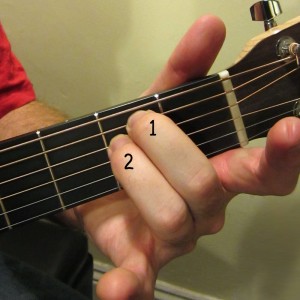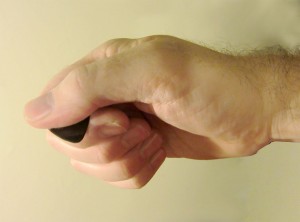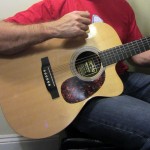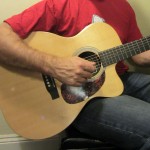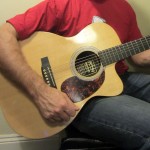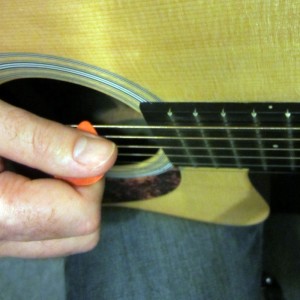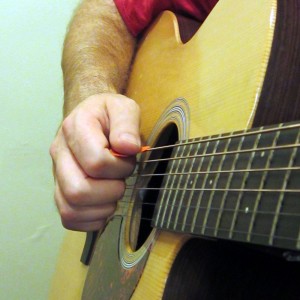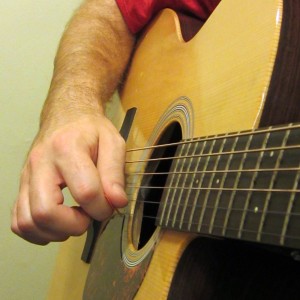The Secrets of Successful Guitar Chord Strumming

A big part of playing songs on the guitar is strumming chords. When you see experienced guitarists strumming it looks pretty easy however many beginner guitarists struggle with their strumming technique. The secret to strumming well on guitar is to master the many skills needed for a good sounding strumming technique.
When learning to strum the first thing that needs to be practiced is the DOWN/UP strumming technique. There are many DOWN/UP strumming patterns for playing all sorts of songs and styles of music on the guitar.
We’ll start off with strumming using the easy 2 finger E minor chord. This is a good chord to use as its easy to hold down for a long period of time as you practice your strumming technique.
While holding down the E minor chord shape ensure you’re holding the guitar pick correctly as shown in the photo below then lightly brush the pick across the strings as you move you arm up and down.
The secrets to successful strumming:
- The strumming movement should come from the elbow and not the wrist.
- Make sure that the strumming movement is a swift decisive chopping motion.
- Ensure that the arm follows through the strings so on a DOWN strum your hand should finish near the bottom of your pick guard (if your guitar has one). With the UP strum the hand should follow through to the top of the guitar body. Think of it like a golf swing with its follow through. If there is not enough follow through the strum can sound very clunky. The strum should have a smooth singular sound.
- Ensure that the pick doesn’t dig in too deep into the strings. It should just brush across them with only a millimetre or two of the pick actually touching the strings.
- While the arm movement should be quick ensure that the wrist is slightly relaxed so the pick doesn’t hit the strings too hard and stiff.
- Finally try rotating your wrist slightly with each UP and DOWN stroke so the pick is not angled into the strings but so it flows over the strings. Think of it like a paintbrush angle moving up and down when painting a wall.
Strumming Patterns and Rhythms
Once you get a feel for the strumming action we will move onto strumming patterns and rhythms.
First we need to look at how rhythm and time is used in music. Music is divided into Bars (separated byBarlines) containing a certain number of beats. A Time Signature tells you how many beats are in a bar and what type of beat it is. The bottom number tells you that the example uses quarter note beats (see table below) while the top number tells you that there are 4 of them in the bar.
Most rock/pop music has 4 beats to the bar. This is why you often hear the drummer in a band counting in “1 2 3 4” at the start of a song. The count of 4 beats is repeated throughout the entire song.
How the note is drawn in sheet music tells you how long the note should be played for whether it be for 1 beat, 2 beats or even half a beat. There are also symbols called Rests which tell you when not to play.
Below is a table showing you the common notes and rests with their matching beat value. A bar of 4 beats is so common that notes are labelled as a fraction of this. A 4 beat note is called a whole note, a half beat note equals 2 beats, a single beat note equals a quarter beat and so on.
A Strumming Pattern
We are now going to practice a strumming pattern using the E minor chord as shown below. The rhythm is made up DOWN/UP strums and a combination of 1 quarter note and 6 eighth notes.
| Strumming Rhythm Notation The root note of the chord will be written (e.g. E note for the E minor chord) using standard music notation to show you the strumming rhythm. This makes the music easier to read and helps you to learn rhythms written in standard music notation. |
You will see that the beat numbers are written under the notes with pluses (+) in between. The pluses are called the OFF beats while the numbers are the ON beats as they’re on the beat.
You usually strum DOWN on an ON beat and UP on an OFF beat.
The rhythm for this pattern is counted as “1—–2-and-3-and-4-and” which also translates to “DOWN—–DOWN-UP-DOWN-UP-DOWN-UP”. Keep in mind that there is no UP strum after the 1st DOWN strum as this note is longer than the others.
| |
E Minor Strumming Pattern | Download |
So now that we’ve uncovered some of the secrets to strumming on the guitar try applying these techniques to other strumming patterns and songs.
This is a small sample from the book Learning To Play The Guitar – An Absolute Beginners Guide now available at Amazon.co
